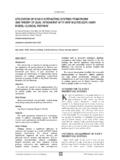Transcription of MINIMUM FLIGHT CREW AC 23 - Federal Aviation …
1 MINIMUM FLIGHT CREW AC JANUARY 12, 2005 Initiated By: ACE-100 1/12/05 AC FOREWORD The advisory circular (AC) system became effective in 1962. It provides a single, uniform, agency-wide system that the Federal Aviation Administration (FAA) uses to deliver advisory material to FAA customers, industry, the Aviation community, and the public. This AC sets forth one method that may be used to show compliance to the requirements contained within 14 CFR, part 23, , which prescribes the certification requirements for MINIMUM FLIGHT crew on part 23 airplanes.
2 S/ Michael K. Dahl Acting Manager, Small Airplane Directorate Aircraft Certification Service i (and ii) 1/12/05 AC CONTENTS 1. 2. 3. APPLICABILITY ..1 4. RELATED REGULATIONS AND a. b. AC's ..2 c. Policy d. AC's for 5. GENERAL CERTIFICATION CONSIDERATIONS ..3 6. CERTIFICATION a. Evaluation Test b. Analytical Approach ..4 c. d.
3 Data Collection and e. Credit for APPENDIX 1 PILOT BEHAVIORS ASSOCIATED WITH HIGH WORKLOAD ..A1-1 APPENDIX 2 MINIMUM FLIGHT CREW RULE AND WORKLOAD APPENDIX 3 WORKLOAD EVALUATION ANNOTATED 1. a. Definition of Workload ..A3-1 b. Performance and c. Workload and APPENDIX 4 RECOMMENDED TEST PLAN GUIDANCE AND DATA COLLECTION INFORMATION ..A4-1 1. DATA COLLECTION TECHNIQUES ..A4-1 a. Selecting Performance Measures, Defining b. Questionnaire iii AC 1/12/05 c. Types of Evaluations Comparative Versus Absolute 2. 3. 4. Data Reduction ..A4-1 5. Level of 6. Questionnaire 7.
4 Rating FIGURE 1 - FORM TO COLLECT PILOT VEHICLE INTERFACE AND WORKLOAD DATA ..A4-4 FIGURE 2 COLLECT PILOT/USER COMMENTS AND FEEDBACK ..A4-5 FIGURE 3 COLLECT PILOT/USER OPINIONS AND iv 1/12/05 AC 1. PURPOSE. a. This advisory circular (AC) sets forth one method that may be used to show compliance to the requirements contained within 14 CFR, part 23, , which prescribes the certification requirements for MINIMUM FLIGHT crew on part 23 airplanes.
5 B. This AC is one method that can be used to determine workload factors and issues for normal, utility, acrobatic and commuter category airplanes. Material in this AC is neither mandatory nor regulatory in nature and does not constitute a regulation. c. This material is a reference for part 23 airplane manufacturers, modifiers, Federal Aviation Administration (FAA) design evaluation engineers, FLIGHT test engineers, engineering FLIGHT test pilots [Aircraft Certification Office (ACO), and FLIGHT Standards, and Manufacturers] as well as human factors engineering evaluators. This material may be used by FAA authorized designees to perform workload evaluations. d. This AC encourages participation and coordination from all the test community participants described in c.
6 Above. This AC is consistent with the FLIGHT test guidance and workload factors described in the MINIMUM FLIGHT crew evaluation sections and workload factors described in AC 23-8B. This AC is an acceptable means of showing compliance for part 23 on FLIGHT tests and pilot judgments. 2. BACKGROUND. a. In the early 1980s, there was a move to reduce the crew size of the new generation of commercial jet transport airplanes from three to two. This caused the Transport Airplane Directorate to develop more criteria and guidance for MINIMUM crew determination for part 25 airplanes. AC was developed to provide manufacturers and certification personnel a means of showing compliance to 14 CFR, part 25, Most part 23 airplanes are single pilot, none require a crew of three, and only a few require a crew of two.
7 There was no need to address crew complement in these airplanes, and no parallel effort was started then for part 23 airplanes. Replacement of conventional electromechanical instruments with complex integrated electronic displays has made it necessary to more closely examine pilot workload for these installations. b. For many years, part 23 airplane cockpits were rather simple in design and used instruments and systems that were also similar in operation. This made it rather easy for pilots to transition safely from one part 23 airplane to another. However, in recent years because of the growth of modern technology and the reduced cost of electronic components, novel and more complex integrated avionic systems are increasingly being installed in part 23 airplanes.
8 These new systems have changed the appearance, operation, and usability of the pilot-vehicle interface. There is also much variation between manufacturers in the design and operational characteristics of these systems. So, there is a concern that pilot(s) familiar and proficient with one system may not be able to understand sufficiently and operate another system. Although many of these systems can improve pilot situational awareness and safety, poorly designed systems can increase pilot workload, and increase the potential for pilot error. Also, the lack of standardization in the design and operation of these systems can negatively affect pilot training and impact performance and safety.
9 So, there is a need to more closely examine pilot workload and error potential in these complex, integrated cockpits. c. In August 2002, the Small Airplane Directorate published Human Factors Policy for Part 23 Airplanes. The policy included discussion of the human factors considerations for The information contained in this AC further describes the human factors considerations referring to that rule. In addition, airplane certification process guidance has also been published to address general certification considerations; these documents include: (1) The FAA and Industry Guide to Product Certification, 1998 (2) The FAA and Industry Guide to Avionics Approvals, 2001 3.
10 APPLICABILITY. This AC is applicable to all part 23 airplanes as a means of showing compliance to 14 CFR, part 23, , MINIMUM FLIGHT crew. When was modified by amendment 23-34 in February 1987, additional workload determination criteria were added for commuter category airplanes. The guidance contained1 AC 1/12/05 this AC provides recommended evaluation criteria for commuter category airplanes. These considerations may also be used to evaluate workload and usability of the pilot vehicle interface on highly modified cockpits of normal, utility, and aerobatic category airplanes. Historically, the majority of part 23 airplanes have been certified for single pilot operation.

















